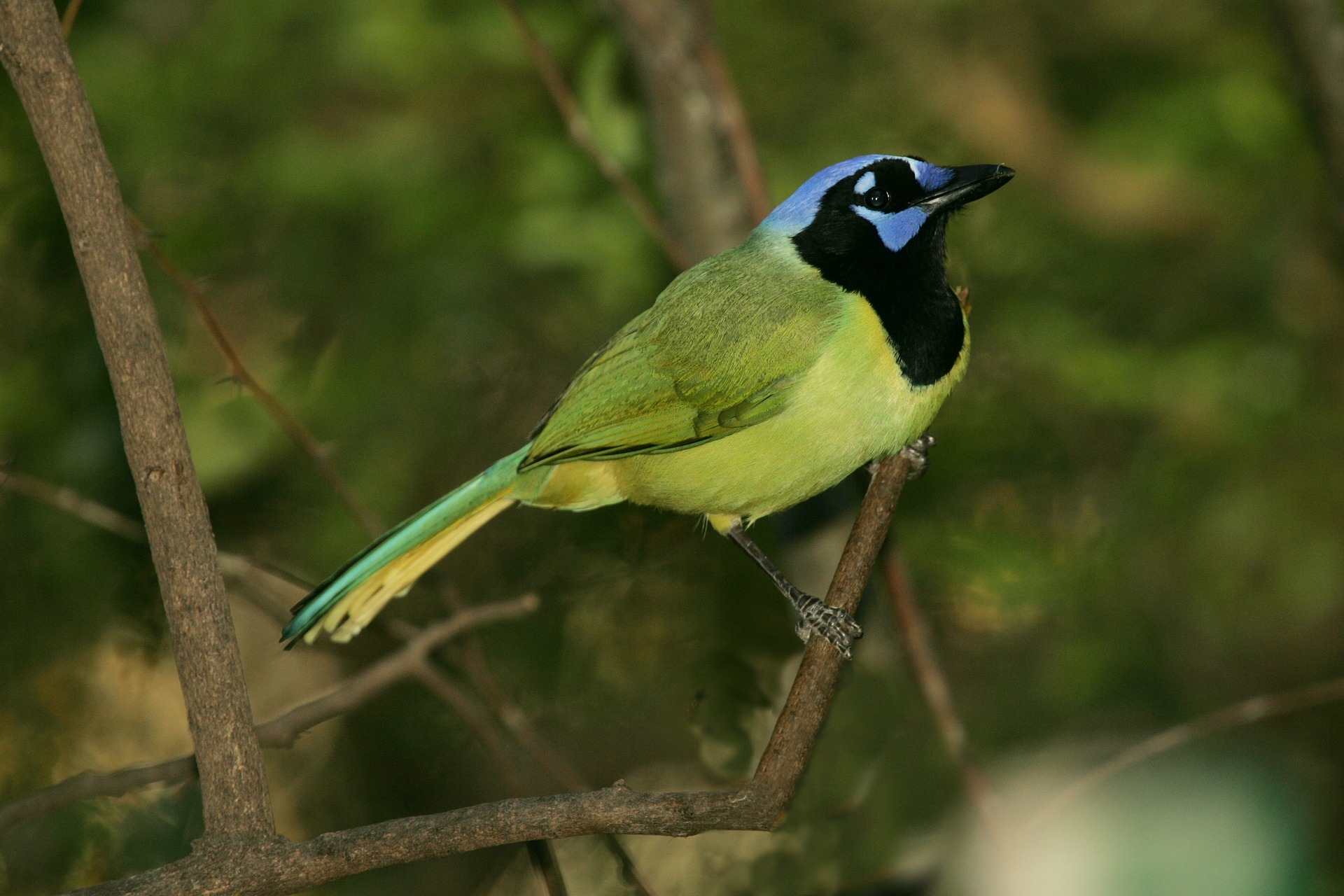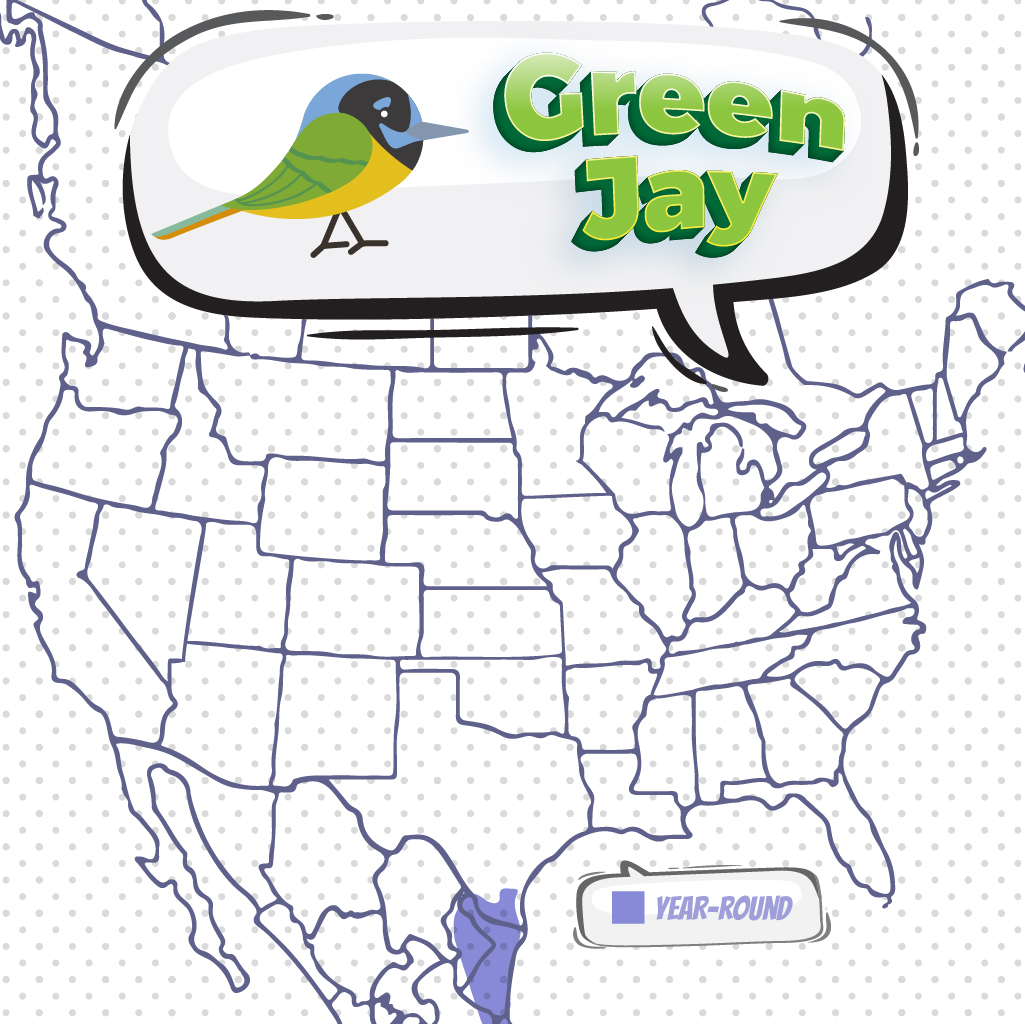
Green Jay
A Green Jay is a fun bird to see while bird watching. Below are some tips to help you identify Green Jays. We have also put together a list of fun Green Jay t-shirts, Green Jaybird patches, birdhouses, bird feeders, binoculars, stickers, and other fun bird-watching items.
About Green Jays
The Green Jay, a native of the dry scrublands of Texas is considered to be one of the most beautiful birds native to South Texas. Its population is mainly found in Mexico and the far southern reaches of the United States.
Description and Identification
Green Jays are similar in size to Blue Jays, at about 11.4 inches in length. They are sturdy
jays without a crest. They have thick and straight bills that are complimented by long,
rounded tails and long legs. Their wings are also broad and appear rounded when they are
in flight. They have yellowish-white feathers with blue tips on the top of their head, cheeks,
and nape, although the amount of blue is variable across regions while their breast and
underparts range from bright yellow to pale green depending on their native regions, with
southern populations exhibiting more yellow and northern populations donning pale green.
The colors of their irises also range from dark brown to bright yellow depending on the
subspecies scattered throughout their main range. All Green Jays have rich green upperparts and large nasal bristles that form tufts with variations in their conspicuousness.
Green Jay Appearance
They have a very colorful appearance with a wide spectrum of green plumage on their backs and bright yellow underparts. The birds have a blue head with bluish-purple highlights around the eyes and forehead. It also has black coloration around the eyes which extends down to its throat and upper breast. It has a short beak that is blue on the upper side and black on the lower.

Green Jay Feeding
Green Jays are omnivores with very versatile feeding ranges. They eat a great variety of
insects, small vertebrates, seeds, and fruits throughout the year. Their insect prey includes
grasshoppers, crickets, bugs, caterpillars, and flies, but they also consume other
invertebrates like spiders and small lizards. Small vertebrates like frogs and nestlings of
other bird species also form a part of their diet. When insects are scarce during the cooler
months, they consume plant matter like seeds of sabal palm, acacia, ebony, and prickly-ash.
They are active foragers that explore treetops before moving down stem by stem to the
ground. They systematically search each tree before moving on to the next, sometimes
moving leaf litter with their bills to expose insects and anthropods.
They are omnivorous birds and can adjust their diet depending on the food that is available. They feed on small mammals, snakes, lizards, amphibians, invertebrates, berries, nuts, fruits, bird eggs, and nestlings. If they lack food in the wilderness or when they come across it, Green Jays will eat human-prepared food and garbage.
Green Jay Habitat
Green Jays inhabit woodlands and scrubby thickets that are close to water sources, such as
waterways. The trees that they tend to center their habitats around are mesquite, Texas
ebony, huisache, sabal palm, anaqua, and citrus fruit plantations. Populations that live
further south in southern Mexico, Central, and South America frequently inhabit multiple
kinds of wooded habitats like lowland forests, plantations, and rainforests at higher
elevations. They thrive in warm climates and stay in regions that have similar temperatures
all year round.
Its habitat ranges from the dry scrublands of Texas and dry forests to ever-green mountain rainforests. They are non-migratory birds and can live in the same area for a number of years, which can stretch out to be their whole lives.
Range and Migration

Green Jays are brightly colored New World Jays that are marked as tropical through their
vivid plumages. They are mainly found along the Atlantic coasts of Mexico and Central
America, but a few flocks can be found along the Pacific coast of Mexico as well. They are
permanent residents of their native regions and rarely leave their nesting sites in the search of
food sources.
Green Jay Life and Behavior
As it is seen in other birds of the family-like crows, Green Jays are social birds and exhibit communal nesting. They live in “families”, which consists of a mated pair and their younglings. The younglings from the previous year’s breeding stay with the parents and help in raising the following year’s brood. They perform tasks such as nest building and feeding the chicks. If the nestlings are male, they help the male mate in protecting the nest against external attacks.
The males also take up an active role in the bringing up of the young b bringing food to the female and the nestlings and providing protection for the nest.
Green Jay Nesting
Nesting sites are selected by the males and females together, usually around 8.5 feet high
up in dense and brushy vegetation. The construction of the nests is also undertaken jointly
by both members of the pair, wherein they form a thin-walled cup of sticks to form the outer
structure. The inner cup is made through the lining of the structure with roots, mosses,
grasses, vines, and leaves. The resulting structure is usually 8.7 inches across and 4 inches
tall, with the interior cup 3.5 inches across and 2.4 inches deep.
Ornithology
Bird Watching Academy & Camp Subscription Boxes
At Bird Watching Academy & Camp we help kids, youth, and adults get excited and involved in bird watching. We have several monthly subscription boxes that you can subscribe to. Our monthly subscription boxes help kids, youth, and adults learn about birds, bird watching, and bird conservation.
Bird Watching Binoculars for Identifying Green Jays
The most common types of bird-watching binoculars for viewing Green Jays are 8×21 binoculars and 10×42 binoculars. Bird Watching Academy & Camp sells really nice 8×21 binoculars and 10×42 binoculars. You can view and purchase them here.
Green Jay T-shirts
If you love the Green Jay you should purchase a Bird Watching Academy & Camp T-shirt. To help support bird conservation we donate 10 percent to bird conservation activities.
Green Jay Iron On Patches
Kids, Youth, and Adults love to collect our Bird Watching Academy & Camp iron-on patches. Our bird-watching patches help you keep track of the birds you have seen and identified. You can also display the patches on our Bird Watching Academy & Camp banners.
The Green Jay is a great iron-on patch to start your collection with. The patches are durable and can be sewn on or ironed on to just about anything.
Green Jay Stickers
Stickers are a great way for you to display your love for bird watching and the Green Jay. We sell a monthly subscription sticker pack. The sticker packs have 12 bird stickers. These sticker packs will help your kids learn new birds every month.
Bird Feeders for Green Jay
There are many types of bird feeders. Here are our favorite bird feeders for your backyard. We use all of these bird feeders currently. Kids will have a great time watching birds eat at these bird feeders. Using this collection of bird feeders will provide a wide variety and many types of birds.
Best Bird Houses for Green Jay
There are many types of birdhouses. Building a birdhouse is always fun but can be frustrating. These 4 birdhouses have become our favorites. Getting a birdhouse for kids to watch birds grow is always fun. We spent a little extra money on these birdhouses but they have been worth the higher price and look great.









